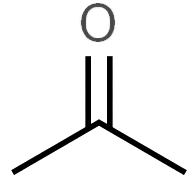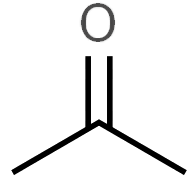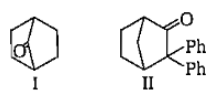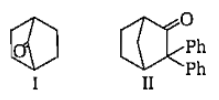Base strength of
(1) H3CCH2
(2) H2C=CH and
(3) H-C=C
1. (2) > (1) > (3)
2. (1) > (3) > (2)
3. (3) > (2) > (1)
4. (1) > (2) > (3)
निम्नलिखित की क्षार सामर्थ्य है-
(1) H3CCH2
(2) H2C=CH और
(3) H-C=C
1. (2) > (1) > (3)
2. (1) > (3) > (2)
3. (3) > (2) > (1)
4. (1) > (2) > (3)
If there is no rotation of plane polarized light by a compound in a specific solvent, thought to be chiral, it may mean that:
1. the compound is certainly a chiral
2. the compound is certainly meso
3. there is no compound in the solvent
4. the compound may be a racemic mixture
यदि एक विशिष्ट विलायक में एक यौगिक द्वारा समतल ध्रुवित प्रकाश का कोई घूर्णन नहीं है, तो काइरल माना जाता है, इसका अर्थ यह हो सकता है:
1. यौगिक निश्चित रूप से काइरल है
2. यौगिक निश्चित रूप से मेसो है
3. विलायक में कोई यौगिक नहीं है
4. यौगिक एक रेसिमिक मिश्रण हो सकता है
A strong base can abstract an -hydrogen from
1. alkene
2. amine
3. ketone
4. alkane
एक प्रबल क्षार किससे एक -हाइड्रोजन पृथक कर सकता है?
1. एल्कीन
2. एमीन
3. कीटोन
4. एल्केन
The acid dissociation constants of the following acids are given as under:
Compound Ka CICH2COOH 136 × 10–5 


(i) The above variation in acidities of the above acids are due to inductive effect only.
(ii) The above variation are both due to inductive and resonance effects.
(iii) Inductive effect varies sharply with distance.
(iv) –I effect of chlorine is not much.
(1) i and ii
(2) i and iii
(3) ii and iii
(4) iii and iv
निम्न अम्लों के अम्ल वियोजन स्थिरांक निम्नानुसार दिए गए हैं:
यौगिक Ka CICH2COOH 136 × 10–5 


इस आकड़े से, निम्नलिखित अवलोकन किए जा सकते हैं। उपर्युक्त यौगिकों के लिए सही कथन को चिह्नित कीजिए।
(i) उपरोक्त अम्लों की अम्लता में भिन्नता केवल प्रेरणिक प्रभाव के कारण होती है।
(ii) उपरोक्त भिन्नता प्रेरणिक और अनुनाद प्रभावों के कारण होती है।
(iii) दूरी के साथ प्रेरक प्रभाव तेजी से परिवर्तित होता है।
(iv) क्लोरीन का –I प्रभाव बहुत अधिक नहीं है
(1) i और ii
(2) i और iii
(3) ii और iii
(4) iii और iv
The correct stability order of following species is :
(1) x > Y > w > z
(2) y > x > w > z
(3) x > w > z > y
(4) z > x > y > w
निम्नलिखित स्पीशीज का सही स्थायित्व क्रम है:
(1) x > Y > w > z
(2) y > x > w > z
(3) x > w > z > y
(4) z > x > y > w
IUPAC name of 
1. but-2-en-2,3-diol
2. pent-2-en-2,3-diol
3. 2-methylbut-2-en-2,3-diol
4. hex-2-en-2,3-diol

1. ब्यूट-2-ईन-2,3-डायोल
2. पेंट-2-ईन-2,3-डायोल
3. 2-मेथिलब्यूट-2-ईन-2,3-डायोल
4. हेक्स-2-ईन-2,3-डायोल
A hydrocarbon (R) has six membered ring in which there is no unsaturation. Two alkyl groups are atttached to the ring adjacent to each other. One group has 3 carbon atoms with branching at 1st carbon atom of chain and another has 4 carbon atoms. The larger alkyl group has main chain of three carbon atoms of which second carbon is substituted. Correct IUPAC name of compound (R) is
(1) 1-(1-Methylethyl)-2-(1-methylpropyl)cyclohexane
(2) 1-(2-Methylethyl)-2-(1-methylpropyl)cyclohexane
(3) 1-(1-Methylethyl)-2-(2-methylpropyl)cyclohexane
(4) 1-(1-Methylethyl)-2-butylcyclohexane
एक हाइड्रोकार्बन (R) में छह सदस्यीय वलय होती है जिसमें कोई असंतृप्ति नहीं होती है। दो एल्किल समूह एक दूसरे से संलग्न वलय से जुड़े होते हैं। एक समूह में पहले कार्बन परमाणु की श्रृंखला पर शाखा के साथ 3 कार्बन परमाणु होते हैं और अन्य में 4 कार्बन परमाणु होते हैं। बृहत् एल्किल समूह में तीन कार्बन परमाणुओं की मुख्य श्रृंखला होती है, जिसमें से दूसरे कार्बन को प्रतिस्थापित किया जाता है। यौगिक (R) का सही IUPAC नाम है-
(1) 1-(1-मेथिलएथिल)-2-(1-मेथिलप्रोपिल) साइक्लोहेक्सेन
(2) 1- (2-मेथिलएथिल)-2-(1-मेथिलप्रोपिल) साइक्लोहेक्सेन
(3) 1-(1-मेथिलएथिल)-2-(2-मेथिलप्रोपिल) साइक्लोहेक्सेन
(4) 1-(1-मेथिलएथिल)-2-ब्यूटिलसाइक्लोहेक्सेन
Maximum enol content is in
1. 
2. 
3.
4. 
अधिकतम इनॉल सामग्री किसमें है-
1. 
2. 
3.
4. 
Which among the given molecules can exhibit tautomerisrn?

1. III Only
2. Both I and III
3. Both Iand II
4. Both II and III
दिए गए अणुओं में से कौन सा चलावयवता प्रदर्शित कर सकता है?

1. केवल III
2. I और III दोनों
3. I और II दोनों
4. II और III दोनों
In the Kjeldahl's method for estimation of nitrogen present in a soil sample, ammonia evolved from 0.75 g of sample neutralised 10 mL of 1 M H2SO4. The percentage of nitrogen in the soil is
1. 37.33 2. 45.33
3. 35.33 4. 43.33
एक मिट्टी के नमूने में उपस्थित नाइट्रोजन के आकलन के लिए केल्डाल की विधि में, 0.75 ग्राम नमूने से अमोनिया मुक्त हुई, जो कि 1 M H2SO4 के 10 mL को उदासीन करती है। मिट्टी में नाइट्रोजन का प्रतिशत है-
1. 37.33 2. 45.33
3. 35.33 4. 43.33







